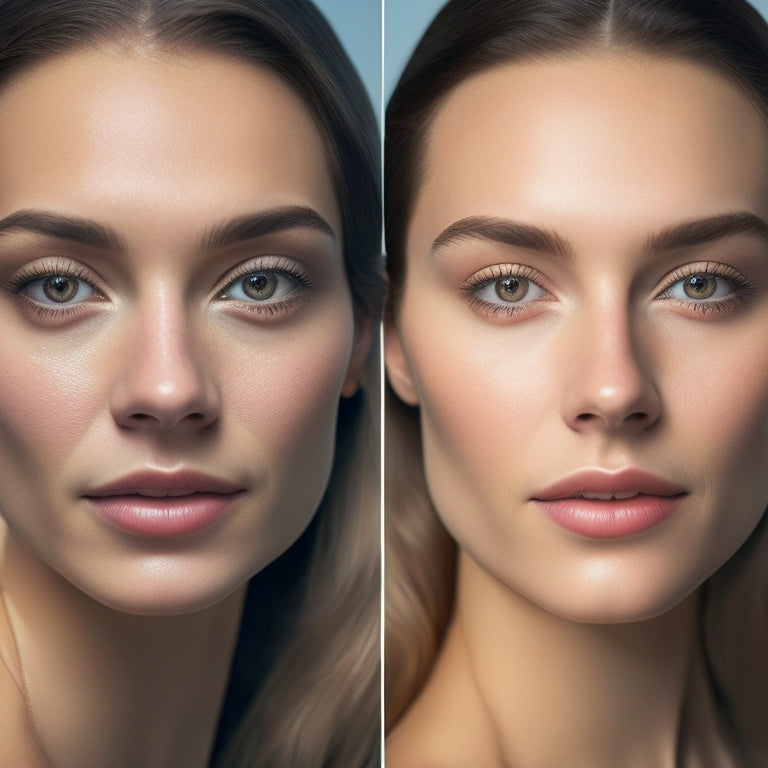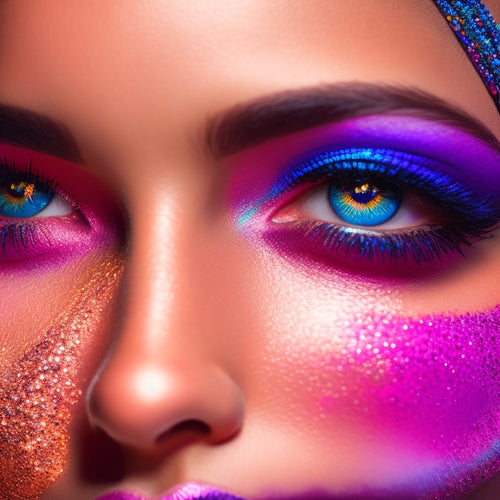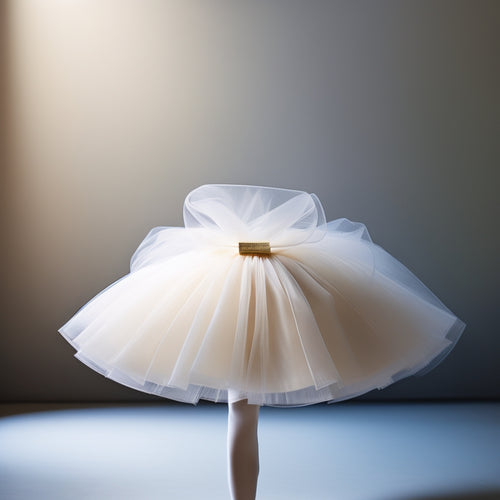
What Makeup Skills Do Beginners Really Need?
Share
To take your makeup skills from basic to brilliant, you need to master several fundamental techniques. First, learn to navigate your makeup toolkit and practice a natural, everyday look. Understanding your skin type and tone is essential, as it affects product performance. Invest in essential brushes and tools, and build a basic makeup kit with lightweight products. Then, enhance your natural features, learn to camouflage blemishes, and master eye and lip makeup basics. By mastering these skills, you'll be well on your way to becoming a makeup pro - and there's even more to discover as you continue on this beauty journey.
Key Takeaways
• Master basic makeup techniques, including brush strokes and product applications, to achieve a natural everyday look.
• Understand your skin type and tone to choose the right products and techniques for a flawless finish.
• Invest in essential makeup brushes and tools, and prioritize cleaning and organization for easy access.
• Learn to enhance your natural features, including defining brows, adding color to cheeks, and enhancing eyes.
• Practice basic eye makeup skills, including eye shape analysis, eyelid mapping, and applying eye shadow, eyeliner, and mascara.
Mastering Basic Makeup Techniques
Get familiar with the fundamentals by learning to navigate your makeup toolkit. Mastering basic makeup techniques is essential to building a solid beauty routine. You'll be surprised at how a simple understanding of brushes, sponges, and applicators can elevate your look.
Start by practicing with a natural, everyday look, focusing on enhancing your features without looking too done-up. As you become more comfortable, experiment with different products and techniques to find what works best for you.
Understanding Skin Types and Tones
When you start to develop your makeup skills, it's crucial to understand your skin type and tone, as these factors greatly impact the way products look and perform on your skin.
You'll need to determine whether you have normal, dry, oily, or combination skin, and then identify your undertones, which can be cool, warm, or neutral.
Determining Your Skin Type
You need to identify your skin type to create an effective makeup routine, and understanding the different skin types and tones is the first step in achieving a flawless, long-lasting look. Determining your skin type is essential, as it affects how products interact with your skin. Take a Skin Type Quiz to determine whether you have normal, dry, oily, combination, or sensitive skin.
Consider your skin's natural moisture levels, oil production, and sensitivity to products. Keep in mind that your skin type can change over time due to Skin Seasonality, hormonal fluctuations, or environmental factors. Be aware of how your skin reacts to different products, temperatures, and humidity levels.
For instance, if you have oily skin, you'll want to focus on oil-controlling products, while dry skin requires moisturizing formulas. Combination skin demands a balanced approach, addressing both oily and dry areas. Sensitive skin needs gentle, soothing products.
Understanding Skin Tones
Now that you've determined your skin type, it's time to explore the world of skin tones, which play a significant role in selecting the perfect makeup shades that will complement your natural complexion. Understanding your skin tone is essential, as it helps you find the most flattering colors that will enhance your features.
To do this, you'll need to perform a complexion analysis. This involves examining the undertones of your skin, which can be warm, cool, or neutral. Warm skin tones have yellow or golden undertones, while cool skin tones have pink or blue undertones. Neutral skin tones are a mix of both.
Once you've identified your undertones, you can start tone matching. This involves finding makeup shades that harmonize with your natural skin tone, creating a seamless finish. When you find the right shades, your makeup will look like a second skin, enhancing your natural beauty without looking cakey or artificial.
Essential Makeup Brushes and Tools
Building a solid makeup kit starts with investing in essential brushes and tools that'll help you achieve flawless, professional-looking results. As a beginner, it's important to focus on the must-haves that'll make a significant difference in your makeup application.
Here are the essential brushes and tools you need to get started:
| Brushes and Tools | Purpose |
|---|---|
| Foundation Brush | Apply foundation and concealer smoothly |
| Powder Brush | Set makeup with a light dusting of powder |
| Blending Brush | Blend eyeshadows for a seamless look |
In addition to these must-have brushes, it's crucial to prioritize Brush Cleaning and Tool Organization. Clean your brushes regularly to prevent bacterial buildup and maintain their quality. Organize your tools in a designated area, making it easy to find what you need when you need it. By investing in these essentials and developing good habits, you'll be well on your way to achieving professional-looking results.
Building a Basic Makeup Kit
With a solid foundation of essential brushes and tools in place, it's time to stock your basic makeup kit with a curated selection of products that'll help you achieve a natural, everyday look. You'll want to focus on Kit Essentials that'll provide a flawless base, enhance your features, and add a touch of color to your complexion.
Start with Makeup Must Haves like a lightweight foundation that matches your skin tone, a concealer one shade lighter to brighten up your under-eye area, and a translucent powder to set everything in place.
Add a soft, peachy blush to give your cheeks a healthy glow, and a neutral eyeshadow palette to create subtle, everyday looks. A black or brown mascara will define your lashes, while a clear or tinted lip balm will keep your lips hydrated and add a hint of color.
Enhancing Natural Features Easily
You've assembled a solid makeup kit, and now it's time to learn how to enhance your natural features without looking or feeling like you're wearing much makeup at all. The goal is to accentuate your best features, not to hide behind layers of product.
Natural accentuation is all about subtly enhancing your fresh face, making you look like the best version of yourself.
To achieve this, focus on defining your brows, adding a touch of color to your cheeks, and enhancing your eyes with a swipe of mascara. These simple steps will give you a radiant, effortless look that's perfect for everyday wear.
Remember, the key is to look like you're not wearing much makeup at all. Keep your application light-handed, and blend, blend, blend!
With a little practice, you'll be mastering the art of natural accentuation in no time, and your fresh face will be looking brighter, smoother, and more radiant than ever.
Concealing Imperfections With Ease
As you continue to refine your makeup skills, you'll want to focus on concealing imperfections with ease. By mastering coverage techniques, you'll be able to hide dark circles, blemishes, and other imperfections that can detract from your natural beauty.
In the following sections, you'll learn how to expertly conceal these flaws and achieve a flawless finish that boosts your confidence.
Mastering Coverage Techniques
Mastering coverage techniques is essential for concealing imperfections with ease, and it begins with understanding the different types of coverage levels and how to select the right one for your skin type and concerns.
When it comes to selecting the right coverage level, you'll want to take into account your skin type, tone, and concerns. Do you have oily skin and require a lightweight, oil-controlling foundation? Or do you have dry skin and need a moisturizing, hydrating formula? Understanding your skin type and concerns will assist you in choosing the ideal coverage level for you.
Here are some key things to keep in mind when mastering coverage techniques:
-
Customizable foundations enable you to customize your coverage to address your individual skin concerns and needs.
-
Sheer buildability allows you to begin with a light layer of coverage and gradually increase as necessary, providing you with ultimate control over your appearance.
-
Layering is crucial for achieving a natural, flawless finish - start with a lightweight foundation and add concealer and powder as needed to achieve your desired level of coverage.
Hiding Dark Circles Effectively
Dark circles, those pesky imperfections that can instantly age your appearance, can be effectively concealed with the right techniques and products, allowing you to wake up looking rested and refreshed.
To hide dark circles effectively, you'll need a Circle Concealer that's one shade lighter than your foundation. Apply it directly to the dark circle, starting from the inner corner and working your way outward. Use a gentle, patting motion to blend the concealer into your skin.
Next, focus on Under Eye Contouring to create the illusion of brighter, more lifted eyes. Use a lighter shade of concealer to highlight the high points of your face, such as the tops of your cheekbones and brow bone. This will help draw attention away from the dark circles and create a more radiant appearance.
Remember to blend, blend, blend! Seamless blending is key to a natural-looking finish. By incorporating these simple techniques into your daily routine, you'll be saying goodbye to dark circles and hello to a more refreshed, youthful you.
Camouflaging Blemishes Quickly
By pinpointing the exact shade of concealer to match your skin tone, you can camouflage blemishes quickly and effortlessly, allowing you to enjoy a flawless complexion in no time.
When it comes to concealing imperfections, it's essential to use the right techniques and products. Here are some tips to help you master the art of camouflaging blemishes quickly:
-
Spot treatment: Focus on individual blemishes rather than applying concealer to your entire face. This will help you target specific areas that need coverage.
-
Choose the right concealer: Select a concealer that's one shade lighter than your foundation to brighten up the area and cover dark spots.
-
Scar camouflage: Use a thicker, more opaque concealer to cover scars or deep blemishes. Apply it with a small brush or a beauty blender for a seamless finish.
Mastering Eye Makeup Basics
Your eyes are the focal point of your face, and learning to accentuate them with makeup can instantly elevate your entire look. As a beginner, mastering eye makeup basics is essential to enhancing your natural beauty.
It all starts with understanding your eye shape. Conduct an Eye Shape Analysis to determine whether you have almond, round, upturned, or hooded eyes. This will help you identify the most flattering techniques and products for your eye type.
Next, map your eyelid to identify the different areas: the brow bone, crease, and lash line. This Eyelid Mapping exercise will help you apply makeup more effectively, creating a smooth shift between colors.
By understanding your eye shape and mapping your eyelid, you'll be able to apply eye shadow, eyeliner, and mascara with confidence. Remember, the key to mastering eye makeup is to enhance your natural features without looking too done-up.
With practice, you'll be able to create a variety of looks that make your eyes sparkle.
Lip Makeup for a Polished Look
Transform your entire look with a polished lip look that effortlessly complements your features. A well-defined lip shape and a bold lip color can instantly elevate your overall appearance. To achieve a polished lip look, start by mastering lip liner techniques. This will help you define your lip shape and create a clean, precise outline.
Here are some essential tips to keep in mind:
-
Use a lip liner that matches your natural lip color to create a natural-looking outline.
-
Experiment with bold lip colors to add a pop of color to your look.
-
Blend, blend, blend! Make sure to blend your lip liner with your lipstick or gloss for a seamless finish.
Creating a Natural Everyday Look
Now that you've mastered the art of defining your lip shape, it's time to focus on creating a natural everyday look that enhances your features without looking too done-up.
A natural everyday look is all about enhancing your natural beauty without looking like you're wearing a lot of makeup. To achieve this, start with a consistent morning routine that includes a gentle skin prep routine. Cleanse your skin thoroughly, moisturize, and prime your face for a smooth canvas.
Then, apply a lightweight foundation that matches your skin tone, blending it seamlessly into your skin. Add a touch of concealer to cover any blemishes or dark circles under your eyes. Define your brows with a brow pencil or powder, and add a swipe of mascara to define your lashes.
Finish off with a subtle blush and a lightweight lip balm, and you're ready to take on the day with a fresh, natural look. Remember, the goal is to look like you're not wearing much makeup at all, so keep it simple and understated.
Troubleshooting Common Makeup Mistakes
Troubleshooting Common Makeup Mistakes
One common pitfall many beginners face is applying too much product, resulting in a cakey, overdone look that's far from the natural everyday look you're aiming for. To avoid this, remember that less is often more. Start with a small amount of product and build up gradually, blending well between layers.
Some common Makeup Mishaps to watch out for include:
-
Inconsistent foundation: Make sure to blend, blend, blend! Especially around the hairline, jawline, and edges of the face.
-
Blending Blunders: Don't forget to blend those eyeshadows, especially in the crease. Harsh lines are a dead giveaway of a beginner's mistake.
-
Unnatural highlights: Avoid overdoing it with the highlighter. A subtle glow is what you're aiming for, not a glittery mess.
Frequently Asked Questions
Can I Use Expired Makeup Without Consequences?
'Like a ticking time bomb, expired makeup hides in your beauty arsenal, waiting to release a world of harm. Don't risk it - using expired products can lead to safety risks, compromising your skin's health and shelf life.'
How Often Should I Clean My Makeup Brushes?
You should clean your makeup brushes at least once a week, ideally daily with a gentle wipe, to prevent bacterial buildup and guarantee peak performance; follow these brush care tips for daily maintenance.
Can I Share Makeup Products With Friends?
When it comes to sharing makeup products with friends, beware of the lurking germs, as it's a recipe for disaster, opening the door to hygiene concerns and product contamination, putting your skin's health at risk.
Do I Need to Use a Makeup Primer Always?
When deciding if you need to use a makeup primer always, consider your skin type and concerns. With various primer types available, conduct a skin analysis to determine the best primer for your skin, ensuring a flawless base for your makeup.
Can I Use Makeup to Change My Face Shape?
You can use face contouring to alter the appearance of your face shape, emphasizing angular features or softening rounder ones; cleverly placed highlights and shadows can create the illusion of a more defined jawline or slimmer nose.
Related Posts
-

Revolutionize Your Dance Makeup With Pro Tutorials
You're about to discover the hidden gems of your dance makeup skills with the latest digital tools and expert guidanc...
-

Explore Vibrant World of Online Dance Learning
The world of online dance learning offers an unparalleled domain of possibilities, where dancers of all levels can ac...
-

Dance Into Elegance: Black & White Ballet Art
Black and white ballet art epitomizes elegance, sophistication, and artistic expression, providing a timeless and ref...


